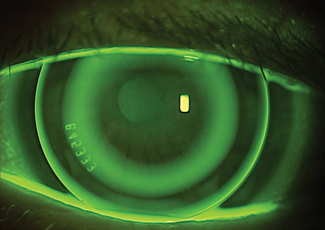 |
|
This study shows that over 60% of ortho-K’s treatment effect was realized during the first year. Photo: Robert Ensley, OD, and Heidi Miller, OD. Click image to enlarge. |
Orthokeratology (ortho-K) lenses have proven to be an effective treatment for myopia management, with the longest history of use for such purposes. A new meta-analysis conducted in China sought to evaluate the modality’s efficacy in slowing the axial elongation of the eye in myopic children. Data from three prospective studies comprising 125 ortho-K subjects and 118 glasses wearers over a two-year period, were pooled together for analysis. Of these, 81% and 75% of ortho-K and control subjects, respectively, completed the two-year follow-up period. Note: Menicon funded the study and one author is an employee of the company.
Ortho-K lens wear was found to provide a clinically and statistically significant reduction in the axial elongation of the eye of 0.24mm, with over 60% of the treatment effect being obtained during the first year of treatment. About 40% the ortho-K subjects experienced remarkably low levels of myopia progression, respectively (two-years axial elongation: ≤0.30mm and >0.59mm, respectively). However, one third of ortho-K lens wearers showed limited benefit in slowing myopia progression and one quarter did not show any benefit from lens wear.
The two-year effect size of 0.24mm is similar to previous studies that have reported that increases in axial length of approximately 0.1mm to 0.2mm annually are typically observed in mild hyperopic to emmetropic Caucasian children, of similar age as those from this study, that remain emmetropic, the researchers noted in their paper on the study for Contact Lens and Anterior Eye.
“If such physiological eye growth is taking into consideration, the treatment effect found in this study would be larger,” the authors explained. “The level of myopia control efficacy found in this study appears to be higher than that reported with various soft contact lens designs used for slowing myopia progression,” in comparable circumstances.
“Furthermore, the 0.24mm two-year effect size is greater than that reported with the only soft contact lens FDA-approved specifically for slowing myopia progression in children. Thus, it is not surprising ortho-K has been perceived over the years as one of the most effective and widely prescribed optical treatment options by eye care practitioners worldwide for slowing myopia progression in pediatric patients.”
The slowing in the axial elongation of the eye in the first year was over 60% of that found in the second year, indicating that there appears to be an initial burst in efficacy during the first year of treatment, with efficacy typically decreasing subsequently over time, the authors noted. “Although the latter appears to be a common feature among different myopia control treatments, some studies have reported cumulative decreases in the axial elongation of the eye following long-term ortho-K lens wear,” the authors explained.
The authors noted that older children typically show lower increases in myopia progression and axial elongation in comparison with younger ones, which could partly account for the older age of the subgroup having full myopia control efficacy (mean age: 9.63 ± 0.74 years) vs. the subgroup that showed no myopia control efficacy (8.28 ± 0.94 years).
“Also of interest is that 41.5% of the ortho-K subjects from this study experienced remarkably low levels of axial elongation (two-year axial elongation ≤0.30mm),” the authors point out. According to the researchers, assuming that the physiological growth of the eye accounts for approximately 0.1mm to 0.2mm annually in white European children, the increases in axial length found in the ortho-K lens wearers classified as having very high and high levels of myopia control efficacy implies that they might not have experienced a true increase in myopia but rather a physiological growth of the eye, indicating that ortho-K lenses were able to arrest myopia progression in this proportion of subjects as well.
In contrast, they note, 33.6% of ortho-K lens wearers classified as having moderate and low levels of myopia control efficacy (growth of 0.30mm to 0.59mm in two years) appeared to have limited benefit from ortho-K lens wear for slowing myopia progression,” the authors explained. “Furthermore, 24.8% of ortho-K lens wearers showed levels of axial elongation equivalent to that found in the control group (>0.59mm), indicating that lens wear does not appear to work in slowing myopia progression in this proportion of ortho-K subjects.”
Santodomingo-Rubido J, Cheung SW, Villa-Collar C, et al. A new look at the myopia control efficacy of orthokeratology. Cont Lens Ant Eye. June 11, 2024. [Epub ahead of print.] |

